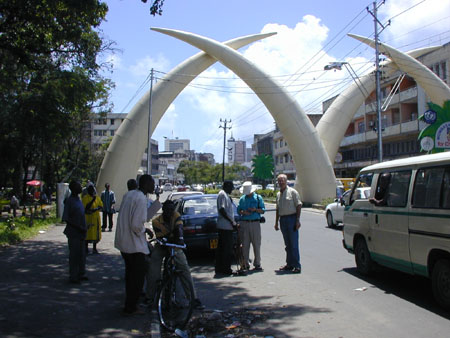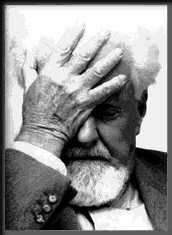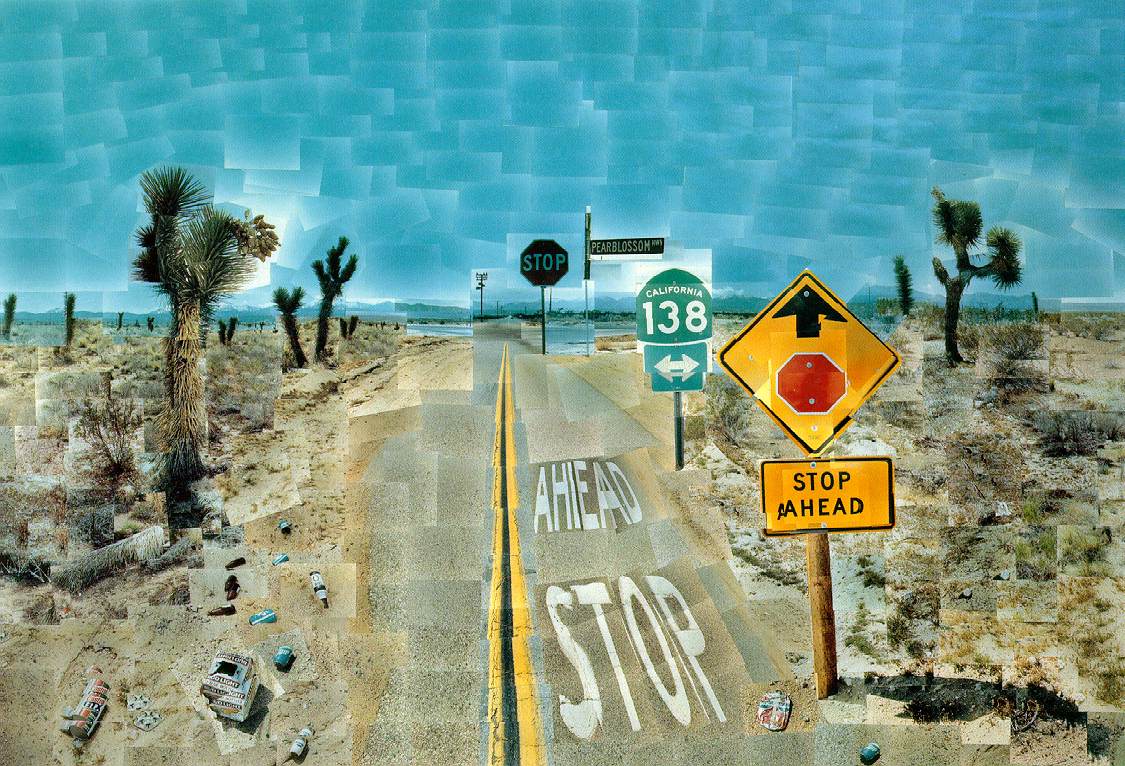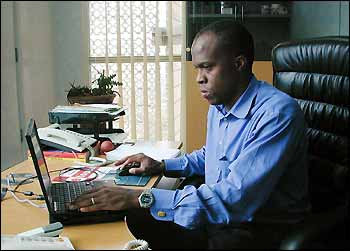1.0.Dazzled By Nature's Beauty
About seventeen days ago, I was standing outside my apartment building in
Notre-Dame-de-Grâce here in western Montreal. For some reason I found myself staring north, full of wonderment.
What held me in thrall was the




beautiful morning. In contrast to the day before, the sun was smiling brightly and very hopefully, beckoning me to go out there and get the best of my day. Chilly as it was, by Quebec standards at this time of the year I was experiencing Equator like conditions. Never mind


the mounds of snow hugging the sidewalks and the swaddled apparitions briskly zipping by on their way to school, work or nowhere in particular.
Bizarre as this may sound, this bright, sunny morning in frigid North America somehow made my mind fly back across the Atlantic and rewind through the decades until this mental video tape paused on a night scene in August of 1973 in my grandfather's compound in Kisa Location,

Kakamega District in the Western Province of

Kenya. It was not so much night as dusk; I am talking of the time between 6:30 and 7:30 where the evening is doing a shift change with night fall, before it gets to the pitch black night that rural Kenyans are so familiar with- a night so dark that you cannot see your hand if you placed it before you and did not shine a torch on it. I was still a Primary School pupil back then attending the nearby AC (for Anglican Church) Luanda Primary School that was literally across the fence from our homestead. But this were the Second Term holidays and if I am not mistaken, we had just come back from looking after our grandfather's half a dozen or so




Zebu cattle, kept more for cultural and recreational purposes in my opinion than as an economic investment: the cow barely produced any milk and the bulls did negligible stud duty among the neighbourhood heifers to my best recollection. Yet every afternoon when we did not go to school we had to take the pathetic animals grazing and watch, eagle eyed, lest they stampede on to any of the tiny shambas where a poor peasant farmer eked out an uncertain living growing maize, beans, sorghum, cow peas, and occasionally, ground nuts (still find it difficult calling them pea nuts). I say it was partly recreational because it gave us something to do and kept us young boys out trouble. The traditional aspect had to do with the fact that many Luos were sedentary mixed farmers who had a smattering of cows, goats, sheep, chicken and in a couple of cases guinea fowl, ducks and very, very rarely, hogs. To take my grandfather as an example. For most of his working life he had been a junior colonial functionary- a court interpreter at
Butere

down the railway line from Yala station. When he retired, sometimes in the fifties when most of daughters and sons were grown and working in places like Nairobi, Kisumu, Eldoret, Gilgil and Muranga he had taken over his father’s old compound(among the Luos the sons have to go ligala, move out and set up their own homes, in chronological order with the first born son first; the daughters are not counted since it is assumed that their new homes will be wherever they will get married in) and converted half of it into a tiny coffee farm with a few hundred trees and half of it given over to bananas, pineapples, maize and assortment of vegetable crops. He focused on the coffee while my grandmother managed the food crops. Even at the age of 96 and even with farm hands, sons and grandsons on hand to help, my grandmother insisted on hauling an ancient hoe to go and cultivate the other shamba just behind her house, across the dirt road from the primary school…
Where was I, and where I am I going?
Yes.
I was gazing at the sky.
In utter wonderment.





All those stars sparkling in the night, twinkling and winking at me.
2.0.When Did the Stars Die?
Years later, when I was beginning to poke my nosy nose into various texts on astronomy I felt very sad, and at first, actually quite startled and frightened to find out that the stars I was looking at were not necessarily the stars which were still there.
I think it was while I was a Form Two student at

Baptist High School





in Mombasa, sitting in one of those Physics double lessons that were always scheduled in the afternoon when you had just come back to school after eating your mother's ugali, sukuma na nyama yenye mifupa during those two hour Kenyan lunch breaks that North Americans are ever perplexed about; it was during those Physics lessons that the concept of light years sort of clued me in to the fact that since it takes literally hundreds of millions of YEARS for light to travel from earth to those stars that we see in the sky, the stars we do see often look the way they looked hundreds of thousands of years ago. This further meant not even our great, great great great great vilembwekeze would ever see how those stars really look like. At least NOT with their naked eyes. Powerful, state of the art telescopes and other scientific innovations has gone a long way in bringing us up to speed about the stars and other bodies out there...
What frightened me back then as a secondary school teenager was to contemplate the mystery of the biography of those stars. Who were they? When were they born? How old were they? Were they still alive? If they died, how did they expire? Would their killers come back from their past to haunt our present or our future?
What made me sad all those years ago was the realization that human beings were smaller than the tiniest microbes when the whole vista of the universe and time-space continuum was taken into account. Consider the fact that our milieu is built around just one among many millions of stars-the solar system is like a pore in the vast skin of the cosmos. Was there more to extra-terrestrial life than the science fiction thrillers- I began wondering more and more, especially after the release of the first Star Wars movie- that I have yet to see even now. Was there a

real E.T. somewhere out there in a far off galaxy?
My melancholy over the mysteries of astronomy did not drive me to the clutches of astrological charlatans, but rather to delve deeper into scientific tomes and grapple with the ideas of various philosophical explorers. During my stint at Kamiti someone (I cannot remember if it was

Gitobu Imanyara or

Maina wa Kinyatti
who lent me

Bertrand Russell's History of Western Philosophy that I immediately immersed myself. Even as I was introduced to teleology, ontology, agnosticism, existentialism, Kant, Locke, Hume, Rousseau, Hobbes, Mill, Nietzsche, Hegel, Feubach, Marx, Engels, Heiddeger and Sartre, I kept reading on my own about the latest scientific breakthroughs since Planck, Niels Bohr, Einstein and other mid-20th Century nuclear scientists.
Parallel to this I was drinking in the ideas of psychologists, psychoanalysts and paranormal dabblers like

Sigmund Freud,

C.G. Jung,

Fromm,

R.D. Laing,

Konrad Lorenz and getting my first whiff of

Michel Foucault's post-modernist counter canons.
Add the layer of contemporary Western art history with figures like

Picasso,

Ernst,

Dali,

Hockney,

Man Ray,

Renoir,

Van Gogh,

Warhol,

Bacon on top of my fascination with Eastern philosophies from Zen Buddhism to Tantric Sex grafted on to my Pan Africanist critique of Euro Centrism and my fledgling Marxist-Leninist political consciousness and my Judeo-Christian upbringing and you begin to get a hint of the sense of turmoil I was thrown into when contemplating topics like general and special theories of relativity, cosmology and the technological imperatives for contemporary humankind.
I mean: we know so much about the world, and yet the much we know is so little, you know what I am saying?
Here we are in this little pond called planet earth with tiny grasshoppers like George Bush smirking as if they just put a down payment on the entire cosmos and yet, in a jiffy, with a flick of the wrist, we and all our hallowed so called achievements could be wiped out just like that, gone in forty seconds as the movie title puts it.
How can we justify our incredible arrogance as a species when we are less than a speck on the eyelids of the universe? Who, exactly, do we think we are?
It is quite safe to say that in two hundred and fifty years from now, not a single person reading these lines will be alive. In fact, the vast majority of my readers, including myself will probably be dead within the next thirty or forty years.
So, what kind of a planet will this earth be?
Will it even be around in the first place?
If the earth still exists and humankind prevails, what kind of a social environment will exist on earth two hundred and fifty years from now?
How many of us even care?
3.0.The Return of Superstitious Gobbledygook in Western Pop Culture
Do me a favour and turn on your telly tonight- if you haven't kicked that idiot box to the curb yet. Arm yourself with your trusty remote control. Now flip through the two hundred and fifty channels that you have subscribed to.
Forget the airhead anchors yammering and jabbering on CNN, MSNBC, CBS, ABC, Fox and NBC. Ignore the steroid drenched ESPN and TSN. Skip the recycled jokes on the Comedy Network. Drive by the heavy rotation of tingling disembodied booties and titties plugging bling bling drivel on a plethora of blathering, lightweight, here today gone tomorrow hip hop sexist clips littering and cluttering MTV, BET, Much Music, Musique Plus and certainly walk past the line dancing on that Nashville based Country Music station. Mute all the commercials for Viagra, Excedrin, Toyota and T. Rowe Price. Apart from the Discovery channel, PBS and TLC how many spaces on the idiot box do you see devoted to science and technology in this idiot box produced by a consumerist culture that has made significant strides in the same fields?
Now count the number of episodes featuring ghosts, angels, devils, imps, witches, wizards, evil spells, ouija boards, psychic dogs, extraterrestrial chicken, superhuman mice, talking pigs, babbling chimpanzees, karate savvy Buddhists and plots drenched in superstition, quackery, charlatanism and plain old myths and legends. Flip back to Jerry Falwell's program and watch him give an extra plug for “creationism” and another dig at evolution.
Now turn off the television and head to the movies. From the

Ring to

Lord of the Rings, the big silver screen is drenched in myths and commercial exploitation of ancient unscientific yada yada yada.
What on earth is going on?
With all the precision used to unleash



the stupid bombs pulverizing thousands of Iraqis the technical hair splitting that goes into coordinating a Rolling Stone stadium concert, it is disconcerting to see the deluge of unscientific exploitation by Hollywood and the mainstream Western media of primordial human fears and the promotion of an empty headed political cult in Washington that is led by a moron who is hostile to such scientific explorations like stem cell research- while diverting billions of dollars that could wipe out poverty and homelessness to be splurged on research and development of the latest weapons of mass destruction.
4.0.So What Does All This Have to Do with M Theory and the Anthrophic Principle?
Search me, dear reader because I too, was pondering what you were pondering.
Just kidding.
As it turns out, a whole lot.
One of the most unlikely candidates for superstar celebrities is a brainiac born in Oxford and educated at Cambridge who travels in



a souped up, bionic wheel chair and uses an artificial voice box during his public lectures on some of the most esoteric, jargon filled, abstract and highly technical and theoretical postulations on cosmology, advanced mathematics, theology and scientific musings that can be found in the moldiest nooks of the stuffiest snob infested ivory towers of the world.
I am talking about that British physics genius, the wisp of a man with a lisp called


Prof. Stephen W. Hawking
Several years ago, I listened to every single comma and semi-colon he uttered in his audio-book,


A Brief History of Time, a surprising mainstay at the top of the bestseller lists even though it dealt with things like Albert Einstein’s Theory of Relativity, the meaning of the universe and other weighty matters that are not automatic paperback page turners.
Stephen Hawking's stellar achievement resides not so much in his brilliant mathematical and astronomical postulations and hypotheses (there are a number of scientists who have publicly taken him on regarding some of his central tenets) but rather in the feat he executed in mainstreaming advanced scientific ideas for the average wananchi.
I mean, the man could have remained ossified and swaddled in the realms of British academia and still have his scientific achievements and reputation intact. But he transcended physics and towered over Oxford when he started writing with a popular, general audience in mind.
Mind you, when I said that he attempted to bridge that academic/popular divide, I am NOT minimizing the fact that he is still very much a cloistered scientist speaking in codes and tongues, uttering a physicist’s glossolalia that requires an auditorium of translators and interpreters to transform his words into Plain English.
Check out this sample of Prof. Hawking's writing, which is NOT the most jargon filled passage that I waded through- actually one of more accessible excerpts:
Cosmology used to be regarded as a pseudo science, an area where wild speculation, was unconstrained by any reliable observations. We now have lots and lots of observational data, and a generally agreed picture of how the universe is evolving. But cosmology is still not a proper science, in the sense that as usually practiced, it has no predictive power. Our observations tell us the present state of the universe, and we can run the equations backward, to calculate what the universe was like at earlier times. But all that tells us is that the universe is as it is now, because it was as it was then. To go further, and be a real science, cosmology would have to predict how the universe should be. We could then test its predictions against observation, like in any other science. The task of making predictions in cosmology is made more difficult by the singularity theorems, that Roger Penrose and I proved. These showed that if General Relativity were correct, the universe would have begun with a singularity. Of course, we would expect classical General Relativity to break down near a singularity, when quantum gravitational effects have to be taken into account.
So what the singularity theorems are really telling us, is that the universe had a quantum origin, and that we need a theory of quantum cosmology, if we are
to predict the present state of the universe. A theory of quantum cosmology has three aspects.
The first, is the local theory that the fields in space-time obey. The second, is the boundary conditions for the fields. And I shall argue that the anthropic principle, is an essential third element. As far as the local theory is concerned, the best, and indeed the only consistent way we know, to describe gravitational forces, is curved space-time. And the theory has to incorporate super symmetry, because otherwise the uncancelled vacuum energies of all the modes would curl space-time into a tiny ball. These two requirements, seemed to point to supergravity theories, at least until 1985. But then the fashion changed suddenly. People declared that supergravity was only a low energy effective theory, because the higher loops probably diverged, though no one was brave, or fool hardy enough to calculate an eight-loop diagram. Instead, the fundamental theory was claimed to be super strings, which were thought to be finite to all loops. But it was discovered that strings were just one member, of a wider class of extended objects, called p-branes. It seems natural to adopt the principle of p-brane democracy. All p-branes are created equal. Yet for p greater than one, the quantum theory of p-branes, diverges for higher loops. I think we should interpret these loop divergences, not as a break down of the supergravity theories, but as a break down of naive perturbation theory. In gauge theories, we know that perturbation theory breaks down at strong coupling. In quantum gravity, the role of the gauge coupling, is played by the energy of a particle. In a quantum loop one integrates over… So one would expect perturbation theory, to break down.
In gauge theories, one can often use duality, to relate a strongly coupled theory, where perturbation theory is bad, to a weakly coupled one, in which it is good. The situation seems to be similar in gravity, with the relation between ultra violet and infra red cut-offs, in the anti de Sitter, conformal field theory, correspondence. I shall therefore not worry about the higher loop divergences, and use eleven-dimensional supergravity, as the local description of the universe. This also goes under the name of M theory, for those that rubbished supergravity in the 80s, and don't want to admit it was basically correct. In fact, as I shall show, it seems the origin of the universe, is in a regime in which first order perturbation theory, is a good approximation.
The second pillar of quantum cosmology, are boundary conditions for the local theory. There are three candidates, the pre big bang scenario, the tunneling hypothesis, and the no boundary proposal.
The pre big bang scenario claims that the boundary condition, is some vacuum state in the infinite past.
But if this vacuum state develops into the universe we have now, it must be unstable. And if it is unstable, it wouldn't be a vacuum state, and it wouldn't have lasted an infinite time before becoming unstable.
The quantum-tunneling hypothesis, is not actually a boundary condition on the space-time fields, but on the Wheeler Dewitt equation. However, the Wheeler Dewitt equation, acts on the infinite dimensional space of all fields on a hyper surface, and is not well defined. Also, the 3+1, or 10+1 split, is putting apart that which God, or Einstein, has joined together. In my opinion therefore, neither the pre-bang scenario, nor the quantum-tunneling hypothesis, are viable.
To determine what happens in the universe, we need to specify the boundary conditions, on the field configurations, that are summed over in the path integral. One natural choice, would be metrics that are asymptotically Euclidean, or asymptotically anti de Sitter. These would be the relevant boundary conditions for scattering calculations, where one sends particles in from infinity, and measures what comes back out. However, they are not the appropriate boundary conditions for cosmology.
We have no reason to believe the universe is asymptotically Euclidean, or anti de Sitter. Even if it were, we are not concerned about measurements at infinity, but in a finite region in the interior. For such measurements, there will be a contribution from metrics that are compact, without boundary. The action of a compact metric is given by integrating the Lagrangian. Thus its contribution to the path integral is well defined. By contrast, the action of a non-compact or singular metric involves a surface term at infinity, or at the singularity. One can add an arbitrary quantity to this surface term. It therefore seems more natural to adopt what Jim Hartle and I called the no boundary proposal. The quantum state of the universe is defined by a Euclidean path integral over compact metrics. In other words, the boundary condition of the universe is that it has no boundary.
There are compact Reechi flat metrics of any dimension, many with high dimensional modulie spaces.
Thus eleven-dimensional supergravity, or M theory, admits a very large number of solutions and compactifications. There may be some principle that we haven' t yet thought of, that restricts the possible models to a small sub class, but it seems unlikely.
Thus I believe that we have to invoke the Anthropic Principle. Many physicists dislike the Anthropic Principle. They feel it is messy and vague, it can be used to explain almost anything, and it has little predictive power. I sympathize with these feelings,but the Anthropic Principle seems essential in quantum cosmology. Otherwise, why should we live in a four dimensional world, and not eleven, or some other number of dimensions. The anthropic answer is that two spatial dimensions, are not enough for complicated structures, like intelligent beings. On the other hand, four or more spatial dimensions would mean that gravitational and electric forces would fall off faster than the inverse square law. In this situation, planets would not have stable orbits around their star, nor electrons have stable orbits around the nucleus of an atom. Thus intelligent life, at least as we know it, could exist only in four dimensions. I very much doubt we will find a non anthropic explanation.
Professor Stephen W Hawking,
Quantum Cosmology, M-theory and the Anthropic
Principle (Public Lecture January 1999)
Very lucid, simple and straight-forward words, no doubt, so let us move on without any further ado.
Just kidding.
What was the good Prof nattering about?
Well, this is how he summarized it:
“This talk (was) based on (my) work with Neil Turok and Harvey Reall. I...describe what I see as the framework for quantum cosmology, on the basis of M theory. I...adopt the no boundary proposal, and…argue that the Anthropic Principle is essential, if one is to pick out a solution to represent our universe, from the whole zoo of solutions allowed by M theory.”
What intrigues me about the work of Stephen Hawking in the context of some of the overarching themes in this digital essay is the way he has mined into the deepest recesses of his intellect to find a scientific and mathematical paradigm to contribute towards an explanation of one of the most enduring mysteries that we still face:
How does the universe look like and what is humankind’s place in it?
A rather philosophical question you would think- not exactly the stuff that makes swotting scientists to start poring over their differentiations, permutations, trigonometrical projections and hypothetical postulations.
There are those who would giggle and snigger about such academic travails wondering with some naïve pragmatism, what use this theoretical musings would be to them and their next door neighbour.
And it is at times like this that one comes face to face with Absolute Ujinga.
The French philosopher Descartes observed dryly:
“I think, therefore I am”.
That dictum has an element of truth in it, especially if you add two words after think, “and act”
In order to be concrete, we often go on very abstract flights of fancy. Sometimes, concrete situations also take us on such abstract flights. Did the idea of the airplane first occurred to a dreamer gazing at a flock of birds fly by in perfect formation? Was the first boat inspired by the quest to find out why an animal as large as the hippo can float on water? How many inventions have been inspired by the sudden and distant clap of thunder? How many technologies were inspired by hunger, disease and want?
How many cars made their first appearance as 3-D models on a clip board? How many cancer fighting tablets were once so many chemical formulae? How many mansions were constructed after solving an equation in algebra?
Can you chew food if your brain is dead?
Does copulation involve any intellectual processes at all?
Marxist-Leninists see the dialectical connection between Theory and Praxis:
Marx and Engels…being free from the prejudices characteristic of the theorists of the exploiting classes, grasped the decisive part by humankind’s practical activities in the process of cognition. They drew the conclusion that humankind’s daily practical activities in production, which created the material basis of social existence, were also of great theoretical significance for cognition. They established, as Lenin pointed out, that “the standpoint of life, of practice, should be first and fundamental in the theory of knowledge.”…Marxism includes practice in the theory of knowledge, viewing practice as the basis and purpose of the cognitive process and as the criterion of the trustworthiness of knowledge. By introducing the standpoint of life, of practice, into the theory of knowledge, Marxism directly connects cognition with industry and agriculture, with the research laboratory and social activities of the masses. Marxism regards theory as the elucidation and generalization of humankind’s practical experience, and not as something differing in principle from practice. Practice and theory are opposites; just as humankind’s material and mental activities are opposites. But these opposites penetrate each other and form a unity of two inseparably connected and interacting aspects of social life. Practice not only poses tasks for theory to solve, directing the scientist’s attention to the study of aspects, processes and phenomena of the objective world that are more important for society. It also creates the material means for their cognition. Practice, in this case primarily industry, furnishes science with instruments and apparatus, and enables the scientist to make experiments involving very complex equipment. Material production enables humankind to amplify our sense organs, to multiply their cognitive possibilities to a tremendous degree. The microscope magnifies the image of objects a hundred and a thousand fold, the electron microscope even a hundred thousand fold, enabling scientists to see and photograph minute particles of matter invisible to the naked eye. By the means of the telescope, humankind is able to perceive the light of stars hundreds of millions of light-years distant from the earth….Science… engendered as it is by practical requirements, exerts a most powerful and ever increasing reciprocal influence on practice. The tremendous technical successes achieved in the great development of the productive forces in the twentieth century were possible solely through the broad and all-embracing application of scientific discoveries in industry, agriculture, transport and communications, and through the embodiment of laws and formulas in machines and devices, in technological processes. With knowledge of the laws of nature, the human mind directs humankind’s material productive activities and is...a force capable of reshaping the human environment… Thus, the connection and interaction of theory and practice of science and production, with the accent on production, is a necessary condition for society’s material and technical progress...
FUNDAMENTALS OF MARXISM-LENINISM, pp 112-4
One of the ways in which the capitalist West helped to destroy socialism in the Soviet Union and other East European states was consciously and deliberately force the socialist oriented states to DIVERT their scientific, research and technological resources not to build up the productive forces forming the basis for an economically prosperous socialist society, but rather a repressive state that kept playing catch up in the arms race. We often forget that it was the Russians who were the first to put a human being in outer space; it is sad that that this quest to land on the moon and other places was more geared towards to underlining military prowess rather than dealing with practical socio-economic problems back here on planet earth. How sad to find the work of thousands of Soviet, Czech, Hungarian, Romanian, Polish and East German scientists geared, not towards conjuring up an increasing array of affordable consumer goods, but rather coming with the fastest Mig fighter, the most deadly Kalashnikov and the most lethal hand grenade. What an atrocious waste of professional talent to find Soviet psychiatrists dehumanized by a state that forced them to carry out experiments on political prisoners; how tragic that the Bulgarian chemists were at least on one occasion more focused on manufacturing lethal vials that could be hidden in umbrellas to kill “dissidents” abroad rather than using their knowledge and experience to come up with better medication; we could go on and on...
Today in America we find that the most lucrative jobs for scientists, researchers and technological professionals are in corporations whose biggest clients are the US military. To find computer professionals more aghast that they cannot improve the latest remote controlled smart bomb rather than narrowing the digital divide is simply obscene; to find the United States wasting billions of tax payer’s money in pie in the sky missile defense systems when they are the sole super power is simply pornographic; to witness the carnage unleashed by the advanced helicopter gun ships at a time when there are millions of homeless people in the streets of America is just plain surreal; to witness the President of the United States blocking the unfettered access on stem cell research while promoting the unscientific ramblings of creationism is beyond stupid. The government induced mass hysteria in the wake of 9/11 has seen more research dollars go towards more efficient security surveillance networks at a time when there are a number of diseases which could use every extra dollar in research funds.
One could go on and on. The basic point is that theory and practice, science and technology do not operate in a vacuum. Every new advance in science and technology is circumscribed by the political and economic environment in which it sprouts in. Scientists can only solve the problems that their political mandarins allow them to.
Take a look at Kenya’s own pool of trained talent. I have a cousin who has remained employed by a major US technology based institution because his skills do not have a Kenyan context where they can be properly utilized and compensated; Hilary Ng’weno who studied nuclear physics went back home to become a journalist;


M.G. Vassanji, another born in Kenyan nuclear physicist, has made a mark, not in his “field” but as a novelist-although one would argue that having made his home in Canada since the 1970s at least, his case may have been more of a personal choice rather than the political and economic confines of his native society.
The Kenyan Diaspora is full of Ngwenos, Vassanjis plus much more. Occasionally an

Ayisi Makatiani breaks from the pack and unleashes a dot.com era Horatio Alger corporate success tale. But even in this case of Africaonline we can see that what was crucial was securing the patronage of key political players- with the name of Ng’weno (the daughter, not the editor) perhaps helping to open certain windows at State House. The flipside of that are two cases that are well known within the ranks of the KCA so I will not mention any names.
Case One involves a highly accomplished Kenyan computer scientist and engineer relocating to Nairobi to take back his skills to the society that nurtured him and sticking out for a couple of years at least only to be forced to relocate back to the country where he got his doctorate and seek stability and affirmation in a corporate context because of the venal corruption, blatant political interference and shoddy state of infrastructure and business incentives. In this case, the Kenya Government does not have a leg to stand on when it decries the brain drain because it has not put in place the structures, policies and culture that will induce brain gain.
Case Two involves a consortium of equally accomplished and educated Kenyan professionals coming together to form a business entity to take advantage of a commercial opportunity that can utilize their technological expertise. The consortium studiously eschews any special treatment, preferring to participate in an open bidding process only to be shafted by some dubious process that rewards shady outfits run by sketchy entrepreneurs from the nether regions of the mother continent. How many twentysomething, thirtysomething and fortysomething Kenyan professionals will abandon their comfy, if alienated Northern confines to go and face the prospects of their faces being bitten off by the vicious sharks close to the powers that be in Nairobi?
I hope I am not being too cryptic and that my readers are capable of reading what is online, not even between the lines...
5.0. Nanoo! Nanoo! Earth to Scientific Nerds: What is Nano Technology?
That is what I wanted to know.
But wait. Before I answer that question I would just like to big up my fellow COMMUNISTS in Cuba. This small Caribbean island nation, despite that horrific US economic blockade has continued to make waves in the world of science and technology. We pointed out as much in a recent digital where we highlighted the fact that Cuba is the pharmaceutical powerhouse of Latin America; has developed special vaccines against meningitis, has used scorpion venom to fight against cancer and the bark of the humble mango tree to come up with a range of palliatives against various ailments. Clearly the government in Havana sees the crucial, dynamic role between political leadership, economic imperatives and the future of science, technology and research. Unlike its other Caribbean neighbours, Cuba does not suffer from the kind of chronic ill-health on a national scale that often IDs a country as underdeveloped.
Back to nanotechnology.
A guy called

Eric Drexler has given what I think is one of the most lucid expositions on molecular nanotechnology so I will just plunk down a chunk from an article posted on his web site:
Manufactured products are made from atoms. The properties of those products depend on how those atoms are arranged. If we rearrange the atoms in coal we can make diamond. If we rearrange the atoms in sand (and add a few other trace elements) we can make computer chips. If we rearrange the atoms in
dirt, water and air we can make potatoes.
Today’s manufacturing methods are very crude at the molecular level. Casting, grinding, milling and even lithography move atoms in great thundering statistical herds. It's like trying to make things out of LEGO blocks with boxing gloves on
your hands. Yes, you can push the LEGO blocks into great heaps and pile them up, but you can't really snap them together the way you'd like.
In the future, nanotechnology will let us take off the boxing gloves. We'll be able to snap together the fundamental building blocks of nature easily, inexpensively and in most of the ways permitted by the laws of physics. This will be essential if we are to continue the revolution in computer hardware beyond about the next decade,
and will also let us fabricate an entire new generation of products that are cleaner, stronger, lighter, and more precise.
It's worth pointing out that the word "nanotechnology" has become very popular and is used to describe many types of research where the characteristic dimensions are less than about 1,000 nanometers. For example, continued improvements in lithography
have resulted in line widths that are less than one micron: this work is often called
"nanotechnology." Sub-micron lithography is clearly very valuable (ask anyone who uses a computer!) but it is equally clear that conventional lithography will not let us build semiconductor devices in which individual dopant atoms are located at specific lattice sites. Many of the exponentially improving trends in computer hardware capability have remained steady for the last 50 years. There is fairly widespread belief that these trends are likely to continue for at least another several years, but then conventional lithography starts to reach its limits.
If we are to continue these trends we will have to develop a new manufacturing technology which will let us inexpensively build computer systems with mole quantities of logic elements that are molecular in both size and precision and are interconnected in complex and highly idiosyncratic patterns. Nanotechnology will let us do this.
When it's unclear from the context whether we're using the specific definition of "nanotechnology" (given here) or the broader and more inclusive definition (often used in the literature), we'll use the terms "molecular nanotechnology"
or "molecular manufacturing."
Whatever we call it, it should let us get essentially every atom in the right place.
Make almost any structure consistent with the laws of physics that we can specify in molecular detail.
Have manufacturing costs not greatly exceeding the cost of the required raw materials and energy.
There are two more concepts commonly associated with nanotechnology:
Positional assembly.
Massive parallelism.
Clearly, we would be happy with any method that simultaneously achieved the first three objectives. However, this seems difficult without using some form of positional assembly (to get the right molecular parts in the right places) and some form of massive parallelism (to keep the costs down).
The need for positional assembly implies an interest in molecular robotics, e.g., robotic devices that are molecular both in their size and precision.
These molecular scale positional devices are likely to resemble very small versions of their everyday macroscopic counterparts. Positional assembly is frequently used in normal macroscopic manufacturing today, and provides tremendous advantages.
Imagine trying to build a bicycle with both hands tied behind your back! The idea of manipulating and positioning individual atoms and molecules is still new and takes some getting used to. However, as Feynman said in a classic talk in 1959: "The principles of physics, as far as I can see, do not speak against the possibility of
maneuvering things atom by atom." We need to apply at the molecular scale the concept that has demonstrated its effectiveness at the macroscopic scale: making parts go where we want by putting them where we want!
One robotic arm assembling molecular parts is going to take a long time to assemble anything large — so we need lots of robotic arms: this is what we mean by massive parallelism. While earlier proposals achieved massive parallelism through self replication, today’s "best guess" is that future molecular manufacturing systems will use some form of convergent assembly. In this process vast numbers of small parts are assembled by vast numbers of small robotic arms into larger parts, those larger parts are assembled by larger robotic arms into still larger parts, and so forth. If the size of the parts doubles at each iteration, we can go from one nanometer parts (a few atoms in size) to one meter parts (almost as big as a person) in only 30 steps.
6.0. Can Kenya Harness Its Untapped Scientific and Technological Expertise?
I am NOT holding my breath as long as neo-colonial arrangements obtain in the country.
Even before we talk of Kenyans with masters and doctorates itching to serve their country, let us just take a brief look at how the system treats Standard 8 pupils whose only crime is to pass their exams.
How many fail to secure secondary school places despite the fact that have not failed?
And of those who do secure those places, how many eventually drop out because their parents cannot afford the school fees?
How many Kenyan teenagers qualify for university? How many are admitted? Of those who graduate with science and technology related degrees, how many land jobs in their fields, whether or not they are prepared to TKK?
Of those scientists and technologists who are actually employed, how many are applying their skills, training and experiences in the jobs they are doing right now? How many of them are affirmed, rewarded and otherwise given incentives to carry out research and formulate innovative scientific and technological solutions for pressing social and economic problems?
Does the existence of the hyacinth problem in Lake Victoria an indication that we do not have the requisite scientific and technological expertise within Kenya or is this just one more red flag underscoring the lack of political will and leadership?
When our very own born in Kenya, trained in Kenya scientists collude with American corporations to STEAL the natural resources from Lake Bogoria, what does this tell us?
When was the last time a street was named after a leading Kenyan scientist for their professional achievements rather than their political connections?
What can make Kenyan computer professionals go back to their home villages to help bridge the digital divide?
What will encourage a doctor trained at Nairobi University to relocate to a dirt poor village in Gem rather than build a lucrative practice in Hurlingham?
What will lure a mechanical engineer trained at Manchester University to go and work in Mwingi?
Many of these questions are rhetorical and largely systemic.
But I would like to take my bazooka and mow down some culprits who lurk within the ranks of Kenyans abroad.
I am referring to the chatter I see in several Kenyan online forums. Specifically I am referring to trash talkers and this is not a surprise since I am one of the biggest magnets for the makohozi spitting demons in human form that vegetate and defecate on this forums.
What I often marvel at is the fact that some of these individuals are very highly trained, often with above average intelligence. These are Kenyans who have acquired a lot of skills. Some of them are employed in very lucrative and senior positions at leading firms, universities and other institutions.
They could choose to share their skills, ideas and training to help popularize scientific and technological ideas and issues on these forums. They could initiate projects linking Kenyans in the Diaspora with folks back home.
Many of them are already doing that, so do not get me wrong. For instance, good people like John Wafula at MEFUSA have pooled their talents, funds and networks to sponsor bright and disadvantaged children in Western Kenya achieve their educational dreams. Currently I see dozens of people responding to an urgent appeal about a certain needy student and that is to be commended very much. There are dozens of similar examples in Europe, North America, the Middle East and other parts of Africa.
Those are NOT the Kenyans abroad I am talking about.
I am referring to those professional foul mouths who have nothing better to do than fan tribal hatred, monger vicious rumours, shut down vigorous forums and otherwise act like complete ASSHOLES when they could be using their brains, their skills, their contacts to foster a democratic, scientific, technological and progressive culture in these forums.
As Leonard Mambo Mbotela used to ask:
Je, Huu Ni Ungwana?
Onyango Oloo
Montreal



